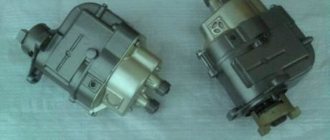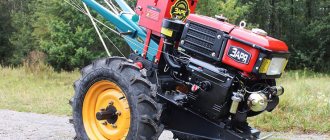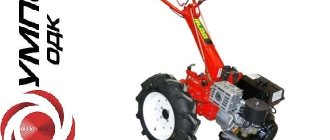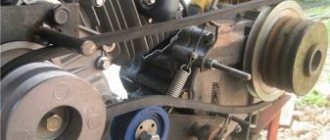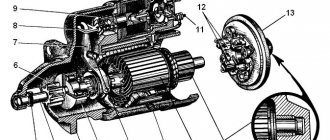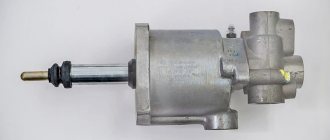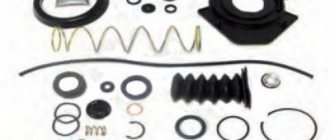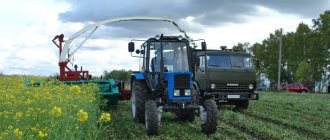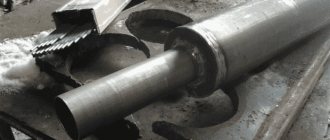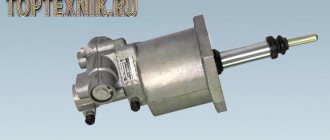Currently, special equipment is used quite often in agriculture and gardening. Here, equipment such as a walk-behind tractor stands out separately. These devices allow you to quickly and efficiently process the soil. However, like any type of equipment, such equipment can also fail. The important components of this device are the motor and transmission. These two components work together, and the coupling is carried out through the clutch disc for an Agro walk-behind tractor or other type of equipment. In this case, it is necessary to consider in detail how the clutch is replaced and repaired on an Agro walk-behind tractor.
You can repair the clutch in this walk-behind tractor yourself
What types exist
Depending on the design features of the walk-behind tractor, the mechanism in question can be of the following types:
- friction;
- hydraulic;
- electromagnetic;
- centrifugal;
- single-disc;
- two-disc;
- multi-disc;
- belt
A centrifugal clutch is used to solve various problems, one of which is to make it easier to control a walk-behind tractor. The clutch ensures a smooth start of movement, since pressing against the clutch disc occurs automatically.
It includes the following components:
- clutch cable;
- flywheel;
- release bearing;
- power lever;
- clutch lever mounted on a walk-behind tractor;
- transmission input shaft;
- driven disk;
- pen;
- lock washer;
- stem fungus;
- shutdown plug.
By the way, if the owner of a walk-behind tractor does not have experience in plumbing, then he will not be able to make a clutch with his own hands. It will only be possible to replace or repair it.
Types of violations in the checkpoint and ways to correct them
If the automatic transmission mechanism has stopped functioning normally, the following types of problems may occur:
- Violation of the kinematic connection inside the gearbox.
- Spontaneous gear shifting or lack of locking.
- Oil leak on the shift shaft.
- Dysfunction of the axle decoupling mechanism.
- No gear shift.
- Gearbox jamming.
If the kinematic connection inside the gearbox is broken or the sprocket in the block breaks, it is necessary to disassemble the gearbox to replace the problematic sprocket. The cause of an oil leak on the shift shaft may be excess oil in the gearbox, so you need to check the oil level. If the welding connection of the gear breaks, disassemble the gearbox and replace the block shaft. After draining the excess oil, you should check the degree of wear of the working edge of the cuff on the shift shaft, disassemble the gearbox and replace the part.
The reason for the lack of gear locking or their spontaneous shutdown is a violation of the adjustment of the gear shift mechanism.
The important role of the differential
Since this mechanism is part of the transmission, it means it is connected to the clutch. The differential has a difficult purpose - making smooth turns, as well as improving the maneuverability of heavy walk-behind tractors. The purpose of the clutch for the walk-behind tractor and the differential is to regulate the rotation of both wheels at different speeds. In addition, power transmission mechanisms can be equipped with wheel locking functions. However, instead of a differential, a special device can be installed that allows you to disable one wheel while driving.
Owner reviews
Basil:
“I didn’t buy my Agros new. I don’t use it very often, since I also have a second walk-behind tractor, and with it I do all the work related to the garden. I have more agro for transportation, like a tractor and labor.
Pros: good speed in 4th gear, enough power to use it as a snow blower. The most worthy walk-behind tractor along with MTZ and Motor Sich.
Disadvantages: almost all owners sooner or later encounter a breakdown of the final drive wheel axle shaft. The previous owner had it that way, he changed it himself. I’m okay so far.”
Extensive functionality
The grip on the walk-behind tractor is of great importance when driving. Without it, it’s difficult to get going, although it’s possible. If it fails, it is better to immediately begin repairing it. A malfunctioning clutch for a walk-behind tractor in a manual transmission leads to damage to the entire transmission. In this sense, the centrifugal clutch has proven itself better, since it has found application in automatic transmissions. If it fails, the walk-behind tractor will not budge at all, which means it will not cause other damage.
The centrifugal clutch for a light walk-behind tractor includes:
- flywheel;
- hub with locking groove and key;
- pulley;
- flange;
- bearing;
- sleeve;
- retaining ring;
- casing
Making a clutch for a heavy or light walk-behind tractor with your own hands requires certain knowledge and experience. If you have them, then get started right now. For reliable operation of the centrifugal type, it is necessary to reduce the weight of the pads to 110 grams. Initially, each of them weighs 134 grams. It is necessary to remove the rubber rings from under the pads and install rigid springs in their place.
Prices in Russia
The Agro walk-behind tractor is widely in demand in branded stores, as well as in the second-hand market. The equipment has been on the market for quite a long time, so there are a huge number of offers on the secondary market. Thus, the average price of a used copy today is 25 thousand rubles. The most complete version will cost about 45 thousand.
As for a new car, everything is much more complicated. Taking into account its high popularity, the new Agro walk-behind tractor in the basic version costs no less than 55 thousand rubles. Often the price reaches 60 thousand rubles.
Agro successfully competes with domestic and imported models, and is relatively inexpensive. In terms of characteristics, this walk-behind tractor can be compared with the Belarus-09N, Burlak 10 DF, and Belarus 08 MT machines.
You shouldn’t start repairing the gearbox on a walk-behind tractor yourself if the operation of the unit and its design are a complete secret to a new user. Since the gearbox is a rather complex unit, you should not proceed to repairing it yourself immediately after detecting breakdowns. It will be better if professionals handle the repair of the gearbox.
If an oil leak is detected from the gearbox, it means that the bearing seals were installed incorrectly or were worn out. They may not be properly tightened on the lids. Damaged gaskets may appear underneath them. If the air valve (breather) is clogged, it is necessary to clean it and bring the oil level to normal. Oil leaks can be eliminated by replacing or correctly installing oil seals or gaskets. Tightening the cover bolts will also help solve the problem.
Walk-behind tractor controls
This is a system of mechanisms that allows you to change the speed and direction of movement of the walk-behind tractor. The controls include the steering wheel, clutch and gear levers, throttle control knob and much more. Since walk-behind tractors do not have a seat for the operator, this means that maneuvering of such equipment is ensured with the help of hands. But, if you can buy a cart with a seat in a specialized store, you will get a mini-tractor.
The clutch is an integral element of the transmission, the task of which is to transmit the torque received by the crankshaft to the gearbox and disconnect the gearbox from the engine when changing the speed of the walk-behind tractor. It is thanks to the presence of this mechanism that the agricultural machine moves off smoothly and can stop without completely turning off the engine.
Purpose and varieties
The clutch carries out inertial transmission of torque from the crankshaft to the transmission gearbox, ensures a smooth start of movement and gear shifting, and regulates the contact of the gearbox with the motor of the walk-behind tractor. If we consider the design features, the clutch mechanisms can be divided into:
- friction;
- hydraulic;
- electromagnetic;
- centrifugal;
- single, double or multi-disc;
- belt
Based on the operating environment, a distinction is made between wet (in an oil bath) and dry mechanisms. According to the switching mode, the device is divided into permanently closed and non-permanently closed devices. Depending on how the torque is transmitted - one flow or two, one- and two-flow systems are distinguished. The design of any clutch mechanism includes the following elements:
- control node;
- leading parts;
- driven components.
The friction clutch is the most popular among farmers who own walk-behind tractors, because it is easy to maintain, highly efficient and lasts for a long period of continuous operation. The principle of operation is the use of friction forces that arise between the contacting edges of the driven and driving parts. The driving components work in rigid connection with the engine crankshaft, and the driven components work with the main shaft of the gearbox or (if it is absent) with the next transmission unit. The elements of the friction system are usually flat discs, but some models of walk-behind tractors have a different shape - shoe or cone.
In a hydraulic system, the moment of motion is transmitted through a fluid, the pressure on which is provided by a piston. The piston returns to its original position using springs. In the electromagnetic type of clutch, a different principle is implemented - the movement of the system elements occurs under the influence of electromagnetism forces.
This type is permanently open. The centrifugal clutch type is used in gearboxes that automatically change gears. Not very common due to rapid wear of parts and long duration of slipping. The disk type, regardless of the number of disks, is based on one principle. It is reliable and ensures smooth startup/shutdown of the unit.
Belt clutches are characterized by low reliability, low efficiency and rapid wear, especially when used with high-power motors.
Clutch for walk-behind tractor - design and principle of operation
The clutch of absolutely any agricultural machine consists of a number of elements. The design of the mechanism includes:
- Constant control device;
- Master node;
- Driven components.
The design of the control mechanism includes a release lever connected to the pressure disk via a pedal lift and rods. When the clutch device of the unit is blocked, a signal is generated that is received by the release levers. They, in turn, disconnect the driven disk from the pressure housing, as a result of which the mechanism is turned off.
The bearing in the clutch assembly of a modern walk-behind tractor serves to reduce friction, while eliminating contact between the levers rotating around their axis and the completely stationary linkage. The spring is responsible for returning the control mechanisms to their original position. At the same time, the branch is pushed away from the levers to the distance required for final shutdown.
Do-it-yourself clutch for a walk-behind tractor
Regular operation of the clutch system involves constant friction of its parts, which is why even the most reliable mechanism sooner or later becomes unusable. After this, you can buy a new device, or try to make a homemade clutch for an agricultural machine.
Before making a clutch for a walk-behind tractor, you will need to prepare certain parts. To work you will need:
- Flywheel and input shaft taken from a gearbox from a Soviet Moskvich;
- Steering knuckle and serviceable hub from Tavria car;
- Driven pulley equipped with two handles;
- Crankshaft from a GAZ-69 car;
- B-profile.
- First, grind the used crankshaft so that it does not touch other internal elements of the device;
- Next, place the standard hub of your walk-behind tractor on the shaft;
- Make a hole in the surface of the shaft to install the bearing. As a result, the hub should be installed without the slightest gap, and the pulley itself should rotate freely around its axis;
- After this, turn the crankshaft over and do the above steps on the reverse side;
- Then make 6 holes in the pulley using a drill with a 5mm bit. There should be the same distance between the holes. Keep in mind that 10mm bolts will be screwed into the holes, so you also need to drill holes on the back side of the pulley;
- Place the pulley on top of the flywheel and bolt the two parts together. Next, mark the places where you need to drill holes. Please note that they must line up with the holes previously drilled in the pulley;
- Pull out the pulley and drill small holes in the flywheel;
- Grind the surface inside the flywheel and shaft so that the parts do not touch each other;
- The mechanism should include the clutch handle on the walk-behind tractor. To make it, take a pipe 30 mm long and about 10 mm in diameter, and fasten it to the pulley;
- You can take the walk-behind tractor clutch cable from an old chainsaw, or buy a new cord and wind it on a reel.
The self-made clutch is suitable for installation on Agro, Neva MB-2 walk-behind tractors and other brands of agricultural machines.
If the design of your walk-behind tractor does not have a clutch, then you can make a clutch frame for the walk-behind tractor with your own hands. This system must transmit torque from the engine crankshaft to the gearbox.
The process is based on the effect of the clutch on the walk-behind tractor. In this case, the motor and gearbox are disconnected. Due to this system, the cultivator begins to move smoothly and stops without turning off the motor.
What do craftsmen most often encounter?
Typically, the following problems occur when working with walk-behind tractors:
- The fuel sump valve is clogged. With such a malfunction, the engine starts to start, but stalls literally after a minute. In this case, it will require thorough cleaning of the sump, then rinsing with gasoline and purging.
- Transmission components get very hot. The reason for this is mainly a lack of transmission oil in the crankcases or its incorrect condition, wear of the bearings. The latter will need to be replaced, the oil may just need to be topped up, only then the problem will be eliminated.
- The ratchet has run out of lubricant. This problem will immediately make itself known with noisy creaking sounds made by the walk-behind tractor engine. The solution is simple - you need to re-lubricate the ratchet with machine oil.
- The spark plug is faulty. Since it does not produce a spark, the engine does not start. If upon inspection you find that the contacts are badly worn and there is dry black soot on the insulation, you will most likely have to replace it.
- Problems with the gear chain. The output shaft may stop rotating, and the gearbox itself will begin to jam sharply. If the chain breaks, the clutch of the Agro walk-behind tractor may be completely damaged and there will be a need to replace it. The condition of such systems should be monitored especially carefully, as they directly affect the level of efficiency of the unit.
What tasks does the clutch for a walk-behind tractor perform?
The clutch for a walk-behind tractor performs the following functions:
- transmits torque;
- dampens rotational vibrations;
- shifts gears smoothly;
- connects gears;
- connects and disconnects the connection between the engine and the gearbox;
- disconnects the transmission from the flywheel.
Depending on the design of the cultivator, there are different types of clutch.
The centrifugal system uses a clutch cable on a walk-behind tractor, a flywheel, a shaft, a handle, a disk, and a washer. Under heavy loads the system slips, so it is not widely used.
The hydraulic clutch of the walk-behind tractor transmits movement to the piston when pressing on the pedal through a connecting rod, which directs the working fluid through the channel using a squeezing method. The piston acts on the lever through the connecting rod, the handle returns back using a spring.
An automatic clutch on a walk-behind tractor is installed on motor cultivators with high engine power. Single-disc and multi-disc systems ensure smooth switching on of the unit and the start of its movement.
Attachments
The walk-behind tractor of the same name is rarely purchased in the basic configuration. After all, in order to appreciate the huge range of Agro’s capabilities, it is necessary to use it with various auxiliary models. Of these, we note only the most common elements recommended by the manufacturer:
- Mounted unit ANM-4
- Mower (segmental) KN-1
- Mower (regular) – KM 0.5
- grouser
- Hiller
- Snow removal product SM-2B
- Potato digger
- Potato planter
- Cart PTM-500
- Milling cutter (several pieces)
- Brush ShchP-09
- Blade The basic package includes only pneumatic wheels and a universal hitch that allows you to connect attachments from third-party brands.
How to make a clutch frame for a walk-behind tractor with your own hands
Let's look at how to make a clutch frame for a walk-behind tractor with your own hands. The belt clutch, which is installed on most cultivators, wears out quickly, the V-belt system does not have high strength and reliability, has low efficiency, and is not used for cultivators with a powerful engine. Therefore, many owners remodel and modernize such a system.
Let's look at how to make a homemade clutch mechanism.
You need to take as a basis:
- flywheel and gearbox shaft from a Moskvich car;
- hub and turning mechanism from a Tavria car;
- metallic profile;
- pulley;
- a steel billet from a GAZ-69 car, which can be used as a crankshaft.
The homemade product is made by sharpening a steel blank on a lathe. This is necessary to put a hub on the manufactured shaft.
Modification of the walk-behind tractor clutch is carried out as follows. After installing the pulley on the shaft, it is necessary to sharpen the seat according to the diameter of the pulley ring for the support bearing.
It is necessary that the hub fits on without gaps and that the pulley rotates well.
After this, you need to turn the device over and perform the same steps on the other side. Then, using a drill with a 5 mm drill, 6 holes are made in the pulley, located at the same distance from each other.
Since 10 mm bolts will be used, holes for the wheel, which is designed to drive the belt, are drilled on the reverse side using a drill with a diameter of 12 mm.
Then a pulley is mounted on the flywheel and holes are made with the same drill, and then the parts are tightened using a bolt.
Characteristics and engine
Agro equipment has the following characteristics: body length - 1800 mm, width and height - 850 and 1100 mm, respectively. Ground clearance is 250 mm, and the minimum turning radius reaches 1200 mm.
The walk-behind tractor has a non-adjustable track - its width is 600 mm. The weight of the entire structure is 160 kg.
Naturally, with such dimensions and weight, the equipment is very difficult to transport. There are many disadvantages, but there are many more advantages. In this case, the main thing is to have a specific idea of where the walk-behind tractor will be used.
The walk-behind tractor is designed for a processing depth of up to 200 mm, and the traction force is 100 kgf.
The maximum weight of transported cargo (with a trailer) is 500 kg. Agro is capable of moving at speeds of up to 15 km/h.
The UMZ-341 1-cylinder petrol carburetor, equipped with air cooling, is responsible for performance. In fact, this engine is a copy of the Japanese Honda GX240. There is support for fuel ranging from A-76 to AI-92. The large tank provides an acceptable range until the next refueling.
With a displacement of 0.3 liters, the power plant develops 8 horsepower and torque is 17 N/m. The engine uses one cylinder with a diameter of 79 mm.
The engine is already initially adapted for use in difficult conditions. In the restyled versions, the developers managed to improve the lubrication system. So, if previously lubrication was carried out by splashing, now the oil is supplied under pressure using a pump. In this way, especially rubbing parts are lubricated. Before entering the rubbing elements, the oil is filtered in a replaceable filter.
Clutch functions in the design of a walk-behind tractor
Clutch operation is based on the action of a friction clutch. This transmission element performs several important functions, among which stand out:
- Uninterrupted transmission of torque;
- Suppression of torsional vibrations;
- Smooth gear shifting;
- Impact-free gear connection;
- Connecting and disconnecting a gearbox with an internal combustion engine;
- Disconnecting the transmission from the flywheel device.
The clutch device makes it possible to briefly disconnect the engine crankshaft and the power transmission of the machine. Thanks to the clutch, the vehicle starts and stops movement smoothly and without jerking.
Centrifugal clutch - design and advantages
This kind of element is worth highlighting among other designs due to its reliability and durability. It is used in automatic transmissions. Its design consists of the following elements:
- Flywheel;
- Pulley;
- Hubs with locking groove and key;
- Flange;
- Bushings;
- casing;
- Bearing;
- Retaining ring.
One of the most important roles is played by the differential device associated with the centrifugal clutch. It helps improve vehicle maneuverability and ensure smooth cornering.
Together with the clutch, the differential regulates the rotation of the walk-behind tractor wheels at different speeds. Moreover, the mechanisms that transmit power together act as wheel lockers. In some models of equipment, instead of a differential, a special device is installed that blocks one of the wheels of the walk-behind tractor at the command of the driver.
More modern models of equipment are equipped with a friction clutch. It is mounted between the engine and gearbox. In this design, the driven parts are closely connected to the gearbox input shaft, and the driving parts are closely connected to the engine crankshaft. In most cases, both the driving and driven elements are made in the form of flat round disks, or in the form of a cone. Just like a centrifugal clutch, a friction clutch is activated by manipulating a separate handle.
Engine starting problems
Motor malfunctions are divided into two categories:
- The engine won't start at all.
- The engine runs, but intermittently.
If the diesel engine on an Agro walk-behind tractor does not start: reasons and solution
- Before starting the engine on a walk-behind tractor, you need to conduct a thorough inspection of all equipment. Are all parts and fasteners in place and how are they secured?
- One of the reasons for this problem may be stagnation after a cold winter, which leads to the following problems: contacts oxidize;
- oil and fuel are watered;
- the jets in the carburetor become clogged;
- The wire insulation may be damaged.
Clutch operating principle
The clutch for a walk-behind tractor consists of several important elements:
- Control devices;
- Leading element;
- Driven parts.
The driving part consists of the end side of the engine flywheel and the pressure plate. The disk rotates together with the attached flywheel. At the same time, the disk can also move axially in relation to the flywheel. Between these two elements there is a driven disk, which is located on the driven shaft. Along the perimeter of the pressure plate there are spring elements in the form of cylinders. The function of springs is based on the compression of the disk they support.
In this case, the other end of the springs is in contact with the casing. Thus, the springs maintain the clutch for the walk-behind tractor in a constantly engaged state.
The control mechanism is made of spin levers connected to the pressure plate housing via rods with a tap and a pedal. When disengaging the clutch, the owner of the walk-behind tractor engages the clutch cable, which transmits force to the spin levers. When the springs are compressed, the levers move the driven disk away from the pressure disk, which leads to the clutch disengaging.
The bearing reduces friction by preventing the fixed link from touching the rotation arms. Most walk-behind tractor models are equipped with three levers located at an angle of 120 degrees relative to each other. With the help of a spring, each clutch lever returns to its original position. In this case, the layer moves to the distance required to turn off the levers. If this distance is not reached, the clutch begins to slip.
How to make a clutch mechanism with your own hands?
The clutch on a walk-behind tractor works on the principle that provides for increased friction of the components, so rapid wear cannot be avoided. In this case, you should try to make the mechanism yourself. The design of a homemade clutch will be composed of:
- input shaft of the gearbox and flywheel of the Moskvich car;
- hub and steering knuckle from Tavria;
- B-profile;
- Double groove driven pulley;
- Crankshaft from GAZ-69.
Subsequent work on assembling the mechanism looks like this:
- First, you will need to grind the crankshaft so that it does not interfere with other elements of the walk-behind tractor;
- We place the standard walk-behind tractor hub on the shaft;
- Next, you need to machine a place on the shaft for the bearing. This operation should be performed as accurately as possible so that the bearing fits perfectly on the shaft. As a result, the hub should fit without any gaps, and the pulley should rotate;
- Then turn the crankshaft over and do the same on the other side;
- Next, use a drill with a 5mm drill bit to make 6 holes in the pulley. The distance between them should be the same. Since 10mm bolts will be used, holes will also need to be drilled on the back of the wheel that drives the drive belt;
- Next, install the pulley on the flywheel and tighten both parts with a bolt. After this, mark the drill spots on the flywheel so that they coincide with the 6 holes in the pulley;
- Remove the pulley and drill holes in the flywheel;
- After this, put the pulley back on and securely tighten the structure with bolts;
- Grind the inner surface of the crankshaft and flywheel so that they do not hit each other.
Basic faults
Belt adjustment and dimensions
For the Neva MB-2 walk-behind tractor, the A-1180 drive belt is used. This model uses one belt that provides forward movement.
In other modifications of the Neva MB-2 model, two drive belts are used. Reverse gearing occurs in the gearbox itself.
Replacing the belt for MB-2 walk-behind tractors is carried out in the following sequence:
- The shield is removed, and then the pulley protective cover.
- The spring from the walk-behind tractor rod is removed to loosen the belt.
- The screws securing the bracket are turned.
- The bracket rotates to a position in which the limiting pins do not prevent the part from being removed from the pulley.
- The pulleys are adjusted, and then a new belt is installed.
- Pull the belt onto the gear shaft pulley, and then onto the motor pulley.
- In reverse order, place the remaining parts in their places.
Replacement of gearbox seals
The oil seals in the Neva MB-2 walk-behind tractor are replaced if an oil leak is detected. This condition is dangerous because the walk-behind tractor gearbox may be left without oil, and this will lead to rapid wear of the unit.
The sequence for replacing oil seals is as follows:
- Remove the cutters from the shaft, cleaning the shaft and covers from dirt and oil residues.
- Unscrew the cover bolts, tap off the oil and debris, and remove the cover from the gearbox.
- The old oil seal is replaced with a new one and wiped dry.
- The cover is returned to its place (if necessary, it is placed on sealant) and fixed with bolts.
Adjusting and tuning the Neva MB-2 carburetor
The functionality and durability of the walk-behind tractor engine depends on the stable operation of the carburetor. This is why its adjustment and tuning are so important. In addition, if the carburetor is incorrectly configured, a gasoline walk-behind tractor may experience increased fuel consumption
The carburetor of the Neva MB-2 walk-behind tractor is adjusted as follows:
- The full throttle and idle screw are turned to the limit.
- Both screws are unscrewed 1-1.5 turns.
- Next comes starting and warming up the engine.
- The throttle control lever is placed in a position in which the engine will operate at minimum speed.
- Set the minimum idle speed until the unit operates stable.
- The idle speed is set to maximum.
- The minimum idle speed is adjusted.
- Steps 6 and 7 are performed until the engine runs smoothly (more smoothly by ear) at idle speed.
For long-term and uninterrupted operation of the walk-behind tractor, it is necessary to regularly perform engine diagnostics, monitor the frequency of oil changes, and also comply with operating conditions and time intervals for scheduled maintenance.
Adjustment of valves
Adjusting the valves is a fairly simple procedure that requires wrenches, screwdrivers and a feeler gauge. The valve adjustment process is needed to establish optimal and technically correct clearances between the valves of a walk-behind tractor engine. Adjusting valves using the example of the Neva MB-23 walk-behind tractor (the principle is the same for everyone)
The adjustment sequence is as follows:
- remove the casing that covers the engine;
- remove the valve box cover;
- make adjustments (see below);
- Reinstall the valve box cover;
- Replace the casing.
The valves are located under the valve cover. The gap size can be checked with a feeler gauge. The intake valve clearance is 0.15 mm, and the exhaust valve clearance is 0.2 mm. The dipstick should fit under the valve with the correct gap size.
To adjust, the valve nuts are loosened, then a feeler gauge is inserted, after which the adjustment itself is made, and the valve nut is tightened.
The manufacturer emphasizes that in Neva MB-2 walk-behind tractors, the gaps between the ends of the valves and the ends of the pushers (0.1÷0.2 mm) are ensured by grinding the ends during the initial assembly of the engine and are not adjusted during operation!
Checking and adjusting the clutch of the Neva MB-2 walk-behind tractor
The main function of the clutch is to connect the gearbox to the engine, disengage it, and also connect other operating devices to the engine. If an overload occurs during operation, the clutch begins to slip - this is how other parts of the walk-behind tractor are protected from damage.
Checking the clutch operation can be done according to the diagram below.
If the clutch lever is in the disengaged position, the clutch cable is loose. Consequently, the tension roller lowers and comes into contact with the drive belt. After which the drive belt and small roller move to the lowered position - this stops the supply of power from the engine to the transmission.
When the clutch lever is moved to the "ON" position, the clutch cable pulls the idler pulley, therefore the bottom of the belt is pressed tightly, the small pulley moves the large pulley and power is transferred.
Adjusting or adjusting the clutch of the Neva MB-2 walk-behind tractor is performed as follows:
- if the clutch lever is engaged, it will lift the tension roller, setting the walk-behind tractor in motion. The correct position is for the V-belts to be parallel on either side of the engine pulley.
- If the clutch lever is loose, the tension roller will drop and disengage the clutch. To avoid disabling the clutch, and therefore slipping the walk-behind tractor, you need to monitor the position of the V-belts, bringing them to a parallel position.
Basic rules for setting the ignition
Checking and setting the ignition on the Neva MB-2 walk-behind tractor is carried out according to the following principle:
- the spark plug is turned out, the electrodes are wiped dry, then the carbon deposits are removed;
- the gap between the electrodes is measured and set;
- the spark plug body is fixed on the cylinder head;
- the crankshaft is scrolled up to 4 times (a starter cord is used for scrolling);
- If the ignition is working properly, a white-blue spark should be struck. Its absence or yellow color indicates a malfunction.
The gap is increased, if necessary, using a feeler gauge. As an auxiliary tool in the absence of a probe, you can use an A4 sheet folded in four or a razor blade. If the gap between the flywheel and the stator is normal, the ignition will work properly.
Malfunctions with spark plugs
First of all, check the performance of the spark plug.
To do this, you need to unscrew the spark plug, wipe the electrodes and remove carbon deposits. Then follow the steps described above in adjusting the ignition. The spark plugs are OK if there is a spark. If there is no spark, the spark plug will probably need to be replaced.
In the operating instructions for the Neva MB-2 walk-behind tractor, the manufacturer indicates the size of the gaps between the electrodes of the spark plugs and the recommended models of spark plugs:
- spark plug A11P (made in Russia) - gap 0.5÷0.6 mm. Wrench dimensions 20.8 mm;
- spark plug NR17С (BRISK) - gap 0.5÷0.6 mm. Wrench dimensions 20.8 mm;
- spark plug WR8AC (BOSСH) - gap 0.5÷0.6 mm. Wrench dimensions 20.8 mm.
Before starting to operate the walk-behind tractor, it is necessary to check whether the sealing washer is installed on the spark plug and whether the sealing washer from the previous spark plug remains in the hole of the cylinder head.
The spark plug can be removed and installed only after the cylinder head has completely cooled down to ambient temperature. If, when removing the spark plug from the engine, the tightening torque was exceeded by more than 50%, further use of such a plug is NOT PERMITTED.
Motoblock Neva MB-2 does not start, shoots, smokes - the main causes of problems and their elimination
In fact, the walk-behind tractor may not start for many reasons. Here are the main ones:
- the wires are oxidized (cleaning and/or replacement is necessary);
- the insulation of the wires is broken (restore/replace the wire);
- the carburetor or gas hose is clogged (cleaning and purging is necessary);
- watering of the oil has occurred (the oil must be drained and replaced);
- there is no spark (replacing the spark plug will help);
- uneven surface on which they are trying to start the walk-behind tractor (install it clearly horizontally so that fuel flows);
- Magneto failure (replacement will help).
If the walk-behind tractor smokes, the reason may be the following:
One of the most common reasons for smoke coming out of a walk-behind tractor may be low-quality fuel, for example, bad gasoline. Smoke can also come from the strong angle of the walk-behind tractor. Another cause of smoke is oil getting on the valve; Burning oil produces thick smoke that will not go away until it is completely burned.
The walk-behind tractor makes shooting sounds and popping sounds. The probable cause of such sounds:
- low fuel level (add fuel to the gas tank);
- debris getting under the needle valve (it is necessary to completely eliminate the debris);
- clogged jets (cleaning helps);
- air filter clogged (blowing helps);
- misalignment of the float axis, low fuel level in the float chamber (adding fuel to the tank will help).
Design and principle of operation of the element
This mechanism, which, at first glance, has a complex design, in practice consists of only a few elements, namely:
- Release bearing.
- The basket where the disks are installed.
- Directly a disk, which, under pressure, diverges into several separate components.
You can also note the presence of couplings and traditional bolt clamps, due to which the structure is mounted on the working plane. The clutch assembly is mounted above the transmission. This device allows the engine main gear to align smoothly with the transmission gear.
If the clutch is missing or damaged, switching becomes difficult, and a metallic crackle is heard at the moment of switching on, since during operation it is difficult for the gears to align at different rotation speeds. In this case, smooth shifting is ensured by a handle from which a cable goes to the mechanism itself. This handle is released when switching.
In this video you will learn how to repair a clutch:
Important! Despite the simplicity of the mechanism, it cannot be said that the element can be easily replaced or repaired; in order to restore or replace a structural component, some skills and experience are required.
What if the gearbox chain fails?
Such a breakdown will be indicated by stopping the rotation of the power take-off shaft of the walk-behind tractor, and the gearbox itself will simply jam. It is possible that the chain itself has burst, then it just needs to be replaced and the PTO will resume its operation. Also, very often owners of walk-behind tractors have problems with adjusting attachments. For example, adjusting a plow on a walk-behind tractor involves the following actions:
- We secure the hitch with 1 kingpin, where the play in the horizontal position should correspond to 5° - 6°.
- We adjust the plowing depth. The norm would be somewhere deep into the ground by 5 - 7 cm.
- Adjusting the angle of attack. Place the walk-behind tractor with the plow on a flat surface. We unscrew the adjusting screw so that the plow touches the ground. And unscrew the screw back until the back of the canopy rises 2.5 cm from the ground.
These are the main points of plow adjustment that need to be made when installing it. Of course, this kind of breakdown of the Agro walk-behind tractor, such as turning on the power take-off shaft or adjusting the clutch, can be eliminated with your own hands without much difficulty. Also, if the Agro walk-behind tractor malfunctions, you should contact its instruction manual, where all problems with such equipment should be described in more detail. If you still understand, for example, that you need to disassemble the imported engine of your unit, that you are not sure that you will do it correctly, then it is still better to turn to specialists. Still, service centers can do detailed diagnostics and determine where the problem is with 100% accuracy. So, when in doubt, it is better to turn to professionals.
The manufacturer of the Agro walk-behind tractor is the public joint-stock company Ufa Engine-Building Production Association, the largest developer and manufacturer of aircraft engines in Russia, which it has produced since its inception. More than 20 thousand people work here. The company was founded in 1925.
Address: 450039, Bashkortostan, st. Ferina, 2, Ufa
Official website of the manufacturer of the Agro walk-behind tractor —
www.umpo.ru
This walk-behind tractor, effectively used both in farming and in household plots, was developed in 1996 and put into mass production in 1998.
In 1999, JSC UMPO began manufacturing a new generation carburetor engine, UMZ-341, developed by factory specialists. This single-cylinder, four-stroke engine produces 8 hp. in all respects it corresponds to the best world analogues, and in Russia it simply has no equal. It was originally created for the Agros walk-behind tractor.
The Agro walk-behind tractor is designed for the mechanization of agricultural work in personal households, farms, gardening, vegetable gardening, as well as in public utilities.
Technical characteristics of the Agro walk-behind tractor
| Name | Meaning |
| Walk-behind tractor type | Universal, single-axis |
| Model | AGRO mod. 001 |
| Overall dimensions, with the steering wheel positioned on the same axis with the steering rod, mm length width height | 1700 ±50 1850 ±50 1100 ±50 |
| Weight, kg structural operational maximum | 150 ± 3 160 |
| Number of gears in transmission forward backward | 4 2 |
| Maximum operating speed (determined by the position of the tiller switch levers and the engine throttle), km/h - Forward: In 1st gear: - with a mounted plow - with a soil cutter In 2nd gear: - with a mounted plow - a trolley with a load of no more than 400 kg On 3rd gear: -cart with a load of no more than 400 kg In 4th gear: -cart with a load of no more than 250 kg -Backward: In 1st gear -with a mower: -with a snow blower: In 2nd gear: -with a cart | |
| Ground vertical clearance, not less, mm | 250 |
| Track, mm | 600+50 or 700+50 with inserts 42T 001.17.00.001 |
| Turning radius at the smallest track 600+50 mm (along the axis of the outer wheel track), m | 1,2 |
| Maximum ford depth, m | 0,3 |
| Limit values of the ambient temperature at which the operation of the walk-behind tractor is ensured | from -20 °С to +40ºС |
| Engine | |
| engine's type | Four-stroke, carburetor forced air cooling |
| Model | UMZ-341 |
| Rated power, kW (hp) | 5.88(8) at 3600 min-1 |
| Fuel | Automotive gasoline A-76 GOST 2084-77 or Normal-80 GOST R51105-97 |
| Other technical characteristics of the engine are given in the engine operating manual | |
| Transmission | |
| Clutch | Friction, conical "dry" type, permanently closed with manual control |
| main gear | Pair of bevel gears with circular teeth |
| Differential | Gear, bevel with 2 satellites with forced locking |
| Final drives | Single-stage spur gears |
| Frame, chassis, steering | |
| skeleton | Frameless, consists of a transmission housing |
| Chassis system: | |
| Type | Wheeled according to the 2×2 scheme |
| Tire size, inch | 6.0 x 12 |
| Air pressure in tires, MPa (kgf/cm2) | 0,08 — 0,12 (0,8 — 1,2) |
| Steering | Rod, adjustable in height, with the possibility of readjustment to a reverse position, to the left or to the right of the main one by 30º |
| PTO | |
| Drive unit | independent |
| Rotation speed of the PTO shaft at an engine speed of 3600 rpm | 1200 |
| Tow hitch | |
| Type | PTO housing with king pin and lock |
| Dimensions and location | See fig. 12 operating instructions |
Operating instructions for walk-behind tractor Agro download
Spare parts for Motoblock Agro catalog
Engine for walk-behind tractor Agro UMZ-341 - user manual download
Catalog of spare parts for the UMZ-341 and UMZ-341E engines - download
To convert the engine to AI-92 gasoline, it is necessary to replace the A11-3 spark plug with an A17B spark plug and adjust the ignition timing, moving it 2 degrees counterclockwise.
Guidelines for converting the UMZ-341 engine and its modifications to AI-92 / AI-80 gasoline download
DESIGN FEATURES.
The universal heavy-class walk-behind tractor "Agro" produced by the Ufa Engine Production Association is a professional type of walk-behind tractor. The weight of 160 kg and the eight-horsepower engine and gear reduction speak for themselves.
The walk-behind tractor is made according to the classic single-axle design with a power take-off shaft. The domestic engine UMZ-341 is gasoline, single-cylinder, 4-stroke, with a power of 5.9 kW (8 hp) at 3600 rpm.
The engine lubrication system is such that the oil does not spray out, but, after being filtered in a replaceable automotive-type filter, is supplied under pressure to the rubbing parts by an oil pump. Two types of oil are required - motor (1.2 liters in the engine crankcase) and transmission (2.5 liters). Initially, the engine was designed for 76 gasoline, but there are guidelines from the manufacturer on how to convert the engine to 92 gasoline.
Detailed technical characteristics of the UMZ-341 engine
The transmission includes a dry bevel clutch, a gear reduction and a positive locking differential, which provides this heavy machine with excellent maneuverability. The gearbox, final drive and differential are housed in one housing. In addition, a PTO and gear shift mechanism are also mounted in it.
Engaging the differential ensures rotation of the drive wheels at different angular speeds, which is necessary when turning the walk-behind tractor and when driving on uneven roads.
The gearbox is four-speed, with reverse. It withstands heavy duty and shock loads well and has a power take-off shaft. True, when reverse gear is engaged, only second and fourth gears are available, but they operate in a “lower” version - the rotation speed is approximately halved.
The steering column can be easily installed at various angles, both vertically and horizontally (plus or minus 30 degrees) and can even be rotated 180 degrees, which allows you to conveniently control the walk-behind tractor when moving “back to front” - for example, when mowing or clearing snow.
When cultivating, an active rotary rotary cutter (122 mm in depth and 440 mm in width) or a special mounted harrow-type ripper with four long blade teeth is used. The plow allows plowing to a depth of 200 mm. Track width - 500-700 mm. With a transport trolley, the walk-behind tractor can transport 500 kg of cargo at a maximum speed of 15 km/h.
But the dimensions of the “Agro” are not small - 1700x850x1100 mm, however, for its class - a heavy, professional walk-behind tractor - they are quite acceptable.
Attachments for the Agro walk-behind tractor.
This machine is for large farms or public utilities, capable of cultivating, plowing, cutting ridges, hilling, harrowing, transporting cargo, cutting grass, throwing snow.
This positioning is also facilitated by a wide range of attachments - these are wheels with pneumatic tires (supplied as a set, which is natural for such a heavy machine), as well as a rotary tiller, a front mower (two modifications - KN-1, KN-1.5), plows - dumps (of various sizes), NPD digger, double-row plow-hiller STV, harrow, harrow-cultivator, several types of lugs, transport cart PTM-500 and snow thrower, which can be purchased additionally. In addition, there is a universal hitch on sale - it allows you to use attachments from other manufacturers on the Agro.
A cooperation agreement signed between the Ufa Engine Production Association, the Chamber of Commerce and Industry of the Republic of Bashkortostan and.
Motoblocks "Agro" have been produced at OJSC "Ufa Engine Production Association" since the late 90s. However, due to the increase in the volume of work of UMPO in the main - aviation - direction, the production of walk-behind tractors is planned to be transferred to another enterprise in Bashkortostan - Ufa-Mechanika LLC. “The transfer of the production of consumer goods (consumer goods), which includes the Agro walk-behind tractor, to production is due to the need to streamline the enterprise’s product line by excluding non-core products.
Since the heavy Agro walk-behind tractor is in great demand on the Russian market, a decision was made not to stop production, but to transfer it to partners in the Chamber of Commerce and Industry.”
Motoblo Agro video
How to replace the UMZ-341 engine installed on an Agro walk-behind tractor with a Lifan. Many people want to replace the engine with a more modern one; this video is very useful for them.
Agro is a family of heavy professional-class walk-behind tractors. Despite its slowness and gluttony, the equipment is distinguished by a high margin of safety and has outstanding capabilities. Possible operational problems can only be associated with maneuverability, since the walk-behind tractor is very heavy and can be compared with full-fledged mini-tractors. In addition, the equipment is equipped with large “toothed” wheels. High reliability and performance have allowed the Agro walk-behind tractor to become one of the most popular in the world.
The machine in question is designed to perform tasks related to cultivation, plowing, hilling, harrowing, building beds, clearing areas of snow, leaves and other debris, as well as for mowing grass and transporting heavy loads.
Agro began to roll off the assembly line of the Ufa Engine Plant. Initially, the model was known under the Agros brand. Soon the manufacturer renamed itself “Agro”.
The walk-behind tractor is based on a classic single-axle design with a power take-off shaft. The model is equipped with a durable transmission. Its main components are a gear reducer, a dry cone-type clutch, and a locking differential. By the way, the last element slightly improves the maneuverability of the product. The gearbox is four-speed. The presence of reverse allows you to turn 360 degrees. This is very convenient, given the large dimensions and weight of the walk-behind tractor. This allows it to be used even in cramped conditions.
High efficiency of the technology was achieved due to the presence of steering column settings. Thus, the column can be adjusted at different angles, namely up to 30 degrees in the horizontal and vertical directions.
The next feature of the walk-behind tractor is the ability to install not only branded equipment, but also connect your own “homemade” devices. Due to this, the walk-behind tractor has almost unlimited capabilities.
DIY repair
To repair the clutch of an Agro walk-behind tractor with your own hands, first of all, you should understand what kind of malfunction we are talking about, since a number of damages cannot be repaired at all and require replacement of the consumable element. Let's look at the main types of faults:
- the release cable has come off (to eliminate this breakdown, you need to check the device for integrity, and then fix it in the same place; you do not need to disassemble the mechanism for this);
- the basket is damaged (these products are made of steel or cast iron, so in case of minor deformations, straightening can be done; this requires completely removing the structural element);
- the release bearing is jammed (here you need to squeeze out the tension cable and try to return the device to its place, but there is no need to dismantle the entire mechanism).
If the ceramic disk is damaged, the basket bursts or is severely deformed, and the release bearing is worn out, then repairing the part is unwise, since the structural element must be replaced, but there is no need to completely change the clutch of the Agro walk-behind tractor.
Important! To replace any consumable item, you need to completely dismantle the device from the walk-behind tractor.
Motoblock Agro: clutch repair
Auto mechanic, specializes in agricultural equipment
Currently, special equipment is used quite often in agriculture and gardening. Here, equipment such as a walk-behind tractor stands out separately. These devices allow you to quickly and efficiently process the soil. However, like any type of equipment, such equipment can also fail. The important components of this device are the motor and transmission. These two components work together, and the coupling is carried out through the clutch disc for an Agro walk-behind tractor or other type of equipment. In this case, it is necessary to consider in detail how the clutch is replaced and repaired on an Agro walk-behind tractor.
Adjustment
During long-term use, this mechanism gradually wears out, which requires adjustment. Let's take a closer look at how this procedure is performed:
- first of all, you should choose a comfortable and spacious place;
- it is necessary to disconnect the clamps;
- it is necessary to release the tension cable;
- Next, you need to lubricate everything with a special substance;
- after this, the cable is tightened and the spring is shortened;
- the bearing needs to be turned to a more suitable position.
During the adjustment process, it is necessary to adjust the length of the cable so that squeezing the handle does not require much effort.
Important! When adjusting (adjusting) the clutch of a walk-behind tractor, it is necessary to lubricate the elements, otherwise there is a risk that the tensioner will break or will not be pressed well again.
Possible causes of breakdowns
- Wear of parts. To avoid this problem, it is necessary to inspect the unit before each start of work.
- Jerking while performing work. In this case, you need to check the tire pressure and adjust the hitch correctly.
- Strong vibrations. To do this, tighten the bolts.
- Difficulty starting the engine. You can solve the problem as follows: check the condition of the oil and parts, tighten the bolts.
- Problems after winter downtime. In this case, the wires quite often oxidize and debris accumulates in the carburetor. To prevent the situation, you should check all parts before use and only then start work.
Product replacement
Changing this device is the most expensive process by financial standards. Although it is not necessary to change all components, experts recommend doing this at the same time. Let's look at how the procedure is performed:
- First of all, parts are purchased.
- Next, you need to completely dismantle the old product.
- All clamps are completely removed and the tension cable is removed.
- After this, you need to clean the landing site.
- Next, the new parts are assembled into a single mechanism.
- The device is mounted on the seat.
- The tensioner is connected to the release bearing through a spring.
- The entire structure is fixed using fasteners.
At first glance, there is nothing complicated about this, but the process is complicated by the fact that it is necessary to remove the clamps, which also partially hold the transmission.
Important! Experts recommend replacing the entire device based on practice, since over time the parts wear in and grind down, which makes it quite difficult to combine the new disk and the old basket, or vice versa.

